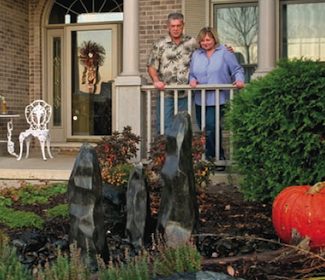RainXchange Rain Collection Systems
Harvesting, or collecting, rainwater that comes off your roof during rains is a growing trend in green home design. Harvesting rainwater has a number of environmentally-friendly attributes, including:
- Reduction of water bills, including sewer charges.
- Stormwater runoff is reduced, alleviating demand on municipal systems.
- Using rain water for irrigation during droughts allow you to circumvent watering restrictions.
One inch of rainfall on a 1,000 square foot roof is equal to over 600 gallons of water! That same roof receiving 30 inches of rain a year can produce over 20,000 gallons of water! When you consider that most U.S. homes use far more water outside than inside, you can see how collecting rainwater for later irrigation use will obviously reduce your home's use of municipal or groundwater.
There are different types of rainwater harvesting systems, from simple rain barrels that can collect 60 gallons to larger above-ground systems capable of storing up to 3,000 gallons. While these above-ground systems are easy to install and use, some homeowners don't want these storage tanks cluttering up their outdoor spaces.
RainXchange Underground Rainwater Harvest Systems
For homeowners who want the benefits of rainwater harvesting without the above-ground tanks, RainXchange offers a unique underground rainwater harvest system to capture and reuse the precious water that would otherwise simply run off your roof. The RainXchange system uses a cutting-edge design that combines underground water collection with a decorative recirculating water feature to add beauty to your landscaping. The RainXchange system is configurable from 500 gallons up to 3000 gallons or more, depending on your needs, budget, and area.
How the RainXchange Rainwater Harvest System Works
The RainXchange Rainwater Harvest System utilizes a 10-stage system that replicates the natural water cycle:
- Downspout Filter: This filter catches rainwater from the downspout, removing pollutants, leaves, twigs, and other debris. A mesh screen that captures smaller particles is easily removable to clean.
- Connecting Pipe: Carries water from the downspout filter to the main storage chamber using only gravity.
- Modular Storage Basin: The main underground storage for water, the modular design is easily configurable to fit any kind of shape or size. The storage basin is made of modular recycled plastic tanks (called Aquablox)that are shipped flat and assembled on-site.
- Snorkel Vault and Centipede Module: These optimize the water usage, and offer a convenient point of access for maintenance and cleaning.
- High Efficiency Pumps: These submersible pumps recirculate water 24 hours a day, and can be used for landscape irrigation.
- Flexible PVC Pipe: The flexible piping allows easy delivery of water to the surface.
- Overflow Filtration: Excess rainwater goes to a separate storage area, where it is filtered and drained into the deep soil and aquifers, just as natural rainfall does.
- Biological Filter: This filter uses beneficial bacteria and enzymes, which reduces organic wastes and pollutants into substances that are absorbed by plants, mimicking the nutrient re-use of natural systems.
- Aquatic Plants: Plants at the surface take up some of the circulated water, providing food and shelter for birds, insects, and other critters.
- Irrigation System: The end use of the entire system, the collected rainwater can be used to water plants, gardens, and lawns with clean, natural water rich in nutrients and free of the chemicals added to municipal water supplies.
Advantages of the RainXchange Rainwater Harvest System
The RainXchange system offers many ecological and aesthetical advantages:
- The system filters and circulates the stored water to prevent stagnation and growth of harmful bacteria, while at the same time giving you a beautiful water feature (fountain or pondless waterfall) that integrates into the landscaping.
- The collection and storage of rainwater takes place underground, out of sight and out of mind, without taking up space and interfering with the outdoor beauty of your home.
- The constantly circulating, aerated water in the RainXchange system provides a natural sanctuary for wildlife, adding biodiversity to your landscaping.
- As mentioned earlier, collecting and reusing rainwater greatly reduces your home's municipal or groundwater usage, minimizing its environmental impacts.
Green Home Design and RainXchange Rainwater Harvest Systems
Incorporating a RainXchange system into your green home's design can qualify for up to 12 LEED credits for your home. These include up to 4 credits for Sustainable Sites, up to 4 credits for Water Efficiency, up to 3 credits for Materials and Resources, and up to 1 credit for Innovation & Design Process.
A system that allows collected rainwater to be used for lawn & garden irrigation and provides a unique,attractive landscape feature to your home's outdoor space will reduce your home's environmental impacts and add to its beauty and value.
Visit the RainXchange website HERE.
Some additional rain harvesting system review articles you may be interested in:
Bushman Rainwater Harvesting
Fiskars Rain Barrel









































































































































